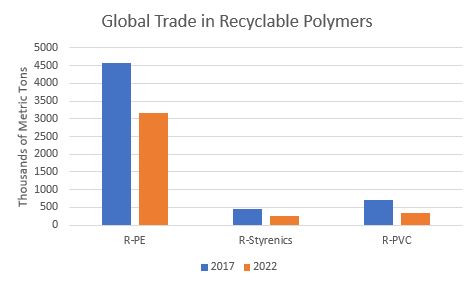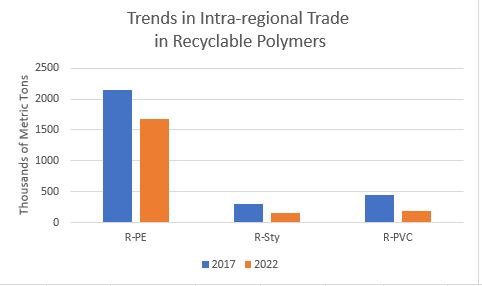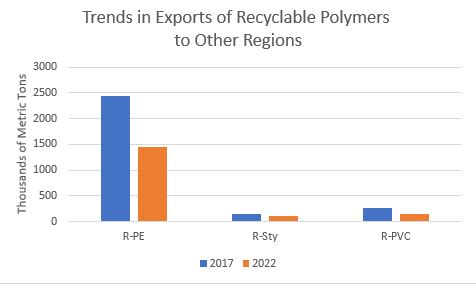Between 2017 and 2022 the volume of global trade for these materials fell. The two main components of global trade, intra-regional trade plus exports to other regions also dropped, although with important differences by region.
Recyclable polymers are waste, parings and scrap that has been collected, can be identified as polymers of ethylene, or styrene or PVC (and, for some countries, also polymers of propylene, and PET) and can potentially be processed mechanically or by other mechanisms, into useful materials. Global trade in different recyclable polymers is classified by specific Harmonized System code numbers. The volume traded globally has fallen sharply over he period 2017 to 2022 (projected).

There are two main categories that make up the global trade total: intra-regional trade, namely, trade between countries within the regions of Western Europe, Eastern Europe, Africa, North America, Latin America, Middle East and Asia-Pacific; and, exports from these regions to other regions. Because exports equal imports, since every export has a corresponding import, only one is counted in the total. Global trade does not, by definition, include what is handled domestically within each country.
Whether intra-regional trade indicates how much material is being recycled into other products depends on the recycling capability of the countries in that region. The total global volume of intra-regional trade fell after 2017 when China banned imports of all recyclable polymers from 2018.

The decline in the global total over the period was due mainly to a drop in trade within the Asia-Pacific region because countries within that region could no longer export to China. Some countries within the region have effective recycling efforts; most do not. For R-PE, Malaysia, Vietnam, and Indonesia are the main importers both from sources within the region and outside of the region. For Recyclable Styrenics it is also Malaysia and Vietnam; for Recyclable PVC, Pakistan, Thailand and Taiwan.
The decline in Asia-Pacific intra-regional trade, however, was partly offset by an increase in trade within Western Europe, which is at the forefront of recycling efforts, likely indicating higher levels of recycling.
The volume of recyclable PE, Styrenics and PVC exported from regions to other regions also declined. Malaysia, Vietnam, Indonesia and Turkey are top destinations for exports from Europe. North America, which tends to understate shipments, exports to several Asia-Pacific countries, including India, and also to Mexico.

From International Trader Publications World Trade Analyses on recyclable polymers.
